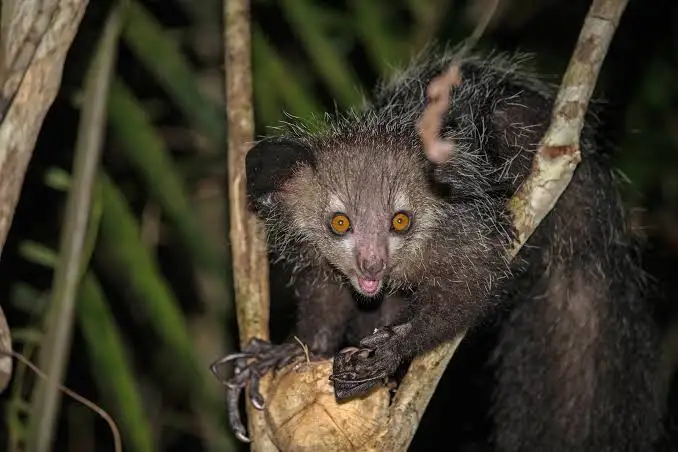The aye aye is one of the most unusual primates in the world. Native to the island of Madagascar, this nocturnal lemur is known for its striking appearance, unusual feeding behavior and mysterious reputation among local communities. With its large eyes, bat like ears and elongated middle finger, the aye aye stands out as a rare example of nature’s creativity.
A Unique Appearance That Sets It Apart
The aye aye has a look unlike any other primate. Its large round eyes help it see clearly at night, while its oversized ears detect even the faintest sounds. Covered in dark shaggy fur, the aye aye moves silently through the forest canopy as it searches for food. One of its most distinctive features is its long thin middle finger, which plays a crucial role in its feeding method.
A Specialized Feeding Technique
Aye ayes use a remarkable technique called percussive foraging. They tap on tree trunks with their elongated finger to locate hidden cavities where insect larvae may be living. Once they detect the sound of hollow wood, they chew a hole with their strong teeth and insert their long finger to extract the larvae. This method is similar to how woodpeckers search for insects, making the aye aye one of the most specialized feeders among primates.
Life in the Forests of Madagascar
Aye ayes inhabit rainforests, mangrove forests and coastal woodlands throughout Madagascar. As nocturnal animals, they spend their days sleeping in spherical nests made of leaves and branches. At night, they travel long distances across the canopy in search of insects, fruits, seeds and nectar. Their agility in trees allows them to avoid predators and remain hidden from human activity.
Cultural Myths and Misunderstandings
In some local traditions, the aye aye is associated with superstition and is believed to bring bad luck. These myths have unfortunately led to fear and persecution of the species in certain regions. Conservationists continue to educate local communities about the ecological importance of the aye aye to reduce negative beliefs and promote protection efforts.
Conservation Status
The aye aye is currently classified as endangered due to habitat loss and misunderstanding. Madagascar’s forests are disappearing rapidly because of agriculture, logging and human settlement. This destruction threatens the survival of the aye aye and many other species that depend on these ecosystems. Conservation projects focus on preserving forests, raising awareness and supporting sustainable livelihoods for local communities.
A Vital Member of Madagascar’s Biodiversity
Despite its unusual looks, the aye aye plays an important role in maintaining the balance of Madagascar’s ecosystems. By controlling insect populations and dispersing seeds, it contributes to forest health and regeneration. The species also serves as a symbol of the island’s extraordinary biodiversity and the need to protect it.
The aye aye is one of the most fascinating and misunderstood animals on the planet. Its unique adaptations, nocturnal lifestyle and cultural significance make it an extraordinary subject of study. Learning about the aye aye reminds us of the importance of protecting endangered species and preserving the natural treasures of Madagascar.





